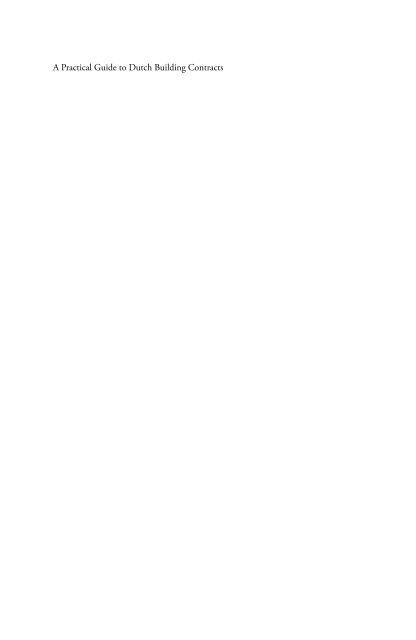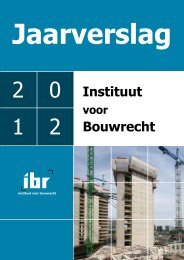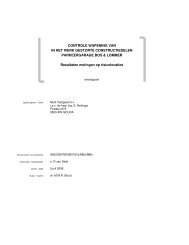A Practical Guide to Dutch Building Contracts - Instituut voor ...
A Practical Guide to Dutch Building Contracts - Instituut voor ...
A Practical Guide to Dutch Building Contracts - Instituut voor ...
Create successful ePaper yourself
Turn your PDF publications into a flip-book with our unique Google optimized e-Paper software.
A <strong>Practical</strong> <strong>Guide</strong> <strong>to</strong> <strong>Dutch</strong> <strong>Building</strong> <strong>Contracts</strong>
A <strong>Practical</strong> <strong>Guide</strong> <strong>to</strong> <strong>Dutch</strong><br />
<strong>Building</strong> <strong>Contracts</strong><br />
M.A.B. Chao-Duivis<br />
A.Z.R. Koning<br />
A.M. Ubink<br />
3 rd edition<br />
’s-Gravenhage - 2013
3 rd edtion<br />
ISBN 978-90-78066-76-7<br />
NUR 822<br />
© 2013, Stichting <strong>Instituut</strong> <strong>voor</strong> Bouwrecht<br />
Alle rechten <strong>voor</strong>behouden. Niets uit deze uitgave mag worden verveelvoudigd, opgeslagen<br />
in een geau<strong>to</strong>matiseerd gegevensbestand, of openbaar gemaakt, in enige vorm of<br />
op enige wijze, hetzij elektronisch, mechanisch, door fo<strong>to</strong>kopieën, opnamen of enige<br />
andere manier, zonder <strong>voor</strong>afgaande schriftelijke <strong>to</strong>estemming van de uitgeverij. Voor<br />
zover het maken van kopieën uit deze uitgave is <strong>to</strong>egestaan op grond van artikel 16h <strong>to</strong>t<br />
en met 16m Auteurswet 1912 jo. het Besluit van 27 november 2002, Stb. 2002, 575,<br />
dient men de daar<strong>voor</strong> wettelijk verschuldigde vergoedingen te voldoen aan de Stichting<br />
Reprorecht (Postbus 3060, 2130 KB Hoofddorp). Voor het overnemen van gedeelte(n)<br />
uit deze uitgave in bloemlezingen, readers en andere compilatiewerken dient men zich<br />
<strong>to</strong>t de Stichting <strong>Instituut</strong> <strong>voor</strong> Bouwrecht te wenden.<br />
No part of this book may be reproduced in any form, by print, pho<strong>to</strong> print, microfilm<br />
or any other means without written permission from the publisher.
Foreword<br />
When registering for a technical education learning <strong>to</strong> design or <strong>to</strong> execute building<br />
activities, one does not realise that the law plays a great part in this. However this is<br />
the case. Parties will have <strong>to</strong> agree on how <strong>to</strong> shape their legal relationship. Does the<br />
employer want <strong>to</strong> be involved or not? Does the designer want <strong>to</strong> stick <strong>to</strong> his copyright<br />
or is he willing <strong>to</strong> transfer this (partly) <strong>to</strong> the employer? Does the contrac<strong>to</strong>r want <strong>to</strong><br />
take care of part of the design works or not? Do the parties want <strong>to</strong> form a completely<br />
new (legal) entity (an alliance) <strong>to</strong> take care of all the activities needed for realising a new<br />
building or not? These are just a few questions needed <strong>to</strong> be answered in the same manner<br />
as so many questions of a technical and management nature need <strong>to</strong> be answered<br />
beforehand.<br />
It is important <strong>to</strong> realise that when non legally trained persons are better aware of these<br />
questions they will be able <strong>to</strong> decide themselves on the answers <strong>to</strong> these questions and<br />
they will be less dependent upon lawyers. The parties themselves will know better than<br />
anyone what the preferred answers are supposed <strong>to</strong> be. On <strong>to</strong>p of that knowledge of the<br />
law will prevent conflicts. Therefore it is a good thing that this book written for students<br />
of technology and construction management is available. Aware of traps one is less likely<br />
<strong>to</strong> walk in<strong>to</strong> them.<br />
As professor in Construction management I am particularly interested in building projects<br />
taking place without conflicts, I hope this book is instrumental in this.<br />
Prof. J.W.F. Wamelink<br />
Chairman Department Real Estate and Housing, Delft University of Technology<br />
v
Table of Contents<br />
Foreword v<br />
1. The Practice of Contracting 1<br />
M.A.B. Chao-Duivis<br />
1.1 Principles of Contract Law 1<br />
1.1.1 The contract 1<br />
1.1.2 Freedom of contract 2<br />
1.1.3 Binding force of agreements 2<br />
1.1.4 No prescribed form 3<br />
1.2 Requirements <strong>to</strong> be met by contracting parties 3<br />
1.2.1 Incapacity 3<br />
1.2.2 Disqualification 4<br />
1.2.3 Representation 4<br />
1.3 Requirements for the creation of a legally valid and inviolable contract 6<br />
1.4 Creation of a contract, pre-contractual negotiations 9<br />
1.5 General Terms and Conditions 9<br />
1.6 Rights in the event of non-fulfilment of an obligation 17<br />
1.6.1 Failure 17<br />
1.6.2 Default 19<br />
1.6.3 Notice of default 20<br />
1.6.4 Rescission 21<br />
1.7 Unforeseen circumstances 24<br />
1.8 Special agreements 24<br />
1.9 <strong>Building</strong> contract models 25<br />
2. The Contract with a Consultant<br />
(The New Rules 2011) 29<br />
A.M. Ubink<br />
2.1 Introduction 29<br />
2.2 Components of the contract 31<br />
2.3 The client’s obligations 32<br />
2.3.1 The duty <strong>to</strong> cooperate 32<br />
2.3.2 Duty <strong>to</strong> warn 33<br />
2.3.3 Payment 33<br />
2.4 The consultant’s obligations 33<br />
2.4.1 Acting as a good and careful contrac<strong>to</strong>r 33<br />
2.4.2 State of the art 34<br />
2.4.3 Legally practicable design 34<br />
2.4.4 Duty <strong>to</strong> inform and duty <strong>to</strong> warn 34<br />
2.4.5 Schedule 35<br />
vii
Table of Contents<br />
2.4.6 Compulsory insurance 35<br />
2.5 The consultant’s liability 36<br />
2.5.1 Liability criteria 36<br />
2.5.2 Limitations of liability 38<br />
2.6 Contract-specific matters 44<br />
2.6.1 Remuneration 44<br />
2.6.2 Power of representation 45<br />
2.6.3 Ownership and copyright 45<br />
2.7 End of the contract 46<br />
2.7.1 Termination 46<br />
2.7.2 Rescission 49<br />
3. The <strong>Building</strong> Contract (UAC 2012) 51<br />
M.A.B. Chao-Duivis<br />
3.1 Introduction 51<br />
3.2 Components of the contract 52<br />
3.2.1 The UAC 2012 and the building contract 52<br />
3.2.2 The specification 52<br />
3.2.3 The UAC 2012 and the specification: order of precedence 52<br />
3.3 The client’s obligations 53<br />
3.3.1 Payment 53<br />
3.3.2 Responsibilities for design and execution 54<br />
3.3.3 Enabling execution <strong>to</strong> take place 57<br />
3.3.4 Supervision 58<br />
3.4 The contrac<strong>to</strong>r’s obligations 61<br />
3.4.1 Execution of the works 62<br />
3.4.2 Duty <strong>to</strong> warn 62<br />
3.4.3 Final completion of the works on time 64<br />
3.5 Liability following final completion 69<br />
3.5.1 Defects liability period 69<br />
3.5.2 The contrac<strong>to</strong>r’s liability following final completion 70<br />
3.6 Contract-specific subjects 73<br />
3.6.1 Additions and omissions 73<br />
3.6.2 Changes in the specification 73<br />
3.6.3 Quantities 76<br />
3.6.4 Unforeseen cost-increasing circumstances 77<br />
3.6.5 <strong>Building</strong> materials and supplies 78<br />
3.7 End of the contract 80<br />
4. The Design Team 83<br />
A.Z.R. Koning<br />
4.1 Introduction 83<br />
4.2 <strong>Contracts</strong> within the design team 86<br />
4.2.1 The coordination agreement 86<br />
viii
Table of Contents<br />
4.2.2 Overview of contracts between the client and the various parties 86<br />
4.2.3 The contract with the architect/consulting engineer 86<br />
4.2.4 The contract with the co-designing contrac<strong>to</strong>r 87<br />
4.3 The client’s role 88<br />
4.4 The design team contrac<strong>to</strong>r’s role 89<br />
4.5 Duty <strong>to</strong> warn 90<br />
4.6 The design team members’ liabilities 91<br />
4.7 The design team contrac<strong>to</strong>r’s liability 93<br />
4.7.1 Liability for advice and designs 93<br />
4.7.2 Limitation of liability 93<br />
4.8 Quotations, price negotiations and the contract for works 94<br />
4.8.1 Legally binding nature 96<br />
4.8.2 Agreement on price 97<br />
4.9 End of the contract 98<br />
5. Integrated <strong>Contracts</strong> (UAC-IC 2005) 99<br />
A.Z.R. Koning<br />
5.1 Introduction 99<br />
5.1.1 General Terms and Conditions 100<br />
5.2 Components of the contract 100<br />
5.3 The client’s role 102<br />
5.3.1 Passive and active involvement on the part of the client 102<br />
5.3.2 The duty <strong>to</strong> cooperate 103<br />
5.3.3 Independent auxiliary persons 105<br />
5.3.4 Payment terms and penalties/bonuses 107<br />
5.3.5 Representation 108<br />
5.3.6 The client’s liability under the UAC-IC 2005 110<br />
5.4 The contrac<strong>to</strong>r’s role 110<br />
5.4.1 Compliance with the requirements 111<br />
5.4.2 Duty <strong>to</strong> warn 114<br />
5.4.3 Representation 114<br />
5.5 Liability 114<br />
5.5.1 Liability for defects following completion 115<br />
5.5.2 Liability for damage 116<br />
5.6 Contract-specific matters 117<br />
5.6.1 Permits and licences, exemptions, decisions,<br />
authorisations and statu<strong>to</strong>ry requirements 117<br />
5.6.2 Soil conditions 120<br />
5.6.3 Variations 124<br />
5.6.4 Quality assurance 124<br />
5.6.5 Reimbursement of costs and extension 129<br />
5.6.6 Intellectual property rights 132<br />
5.7 End of the contract 132<br />
5.7.1 Suspension 133<br />
5.7.2 Rescission and termination 133<br />
ix
Table of Contents<br />
6. Procurement Law 135<br />
M.A.B. Chao-Duivis<br />
6.1 Introduction 135<br />
6.2 Sources of procurement law 135<br />
6.3 Contracting authorities 137<br />
6.4 <strong>Contracts</strong> that must be put out <strong>to</strong> tender 138<br />
6.5 Tendering procedures 139<br />
6.6 How a procedure works 141<br />
6.6.1 Open procedure 142<br />
6.6.2 Restricted procedure 142<br />
6.7 Criteria 143<br />
6.8 The tenderer 145<br />
6.9 The tender 145<br />
6.10 Judicial protection 146<br />
About the authors 149<br />
Further reading 151<br />
Website recommendations 153<br />
Company Profiles 155<br />
x








